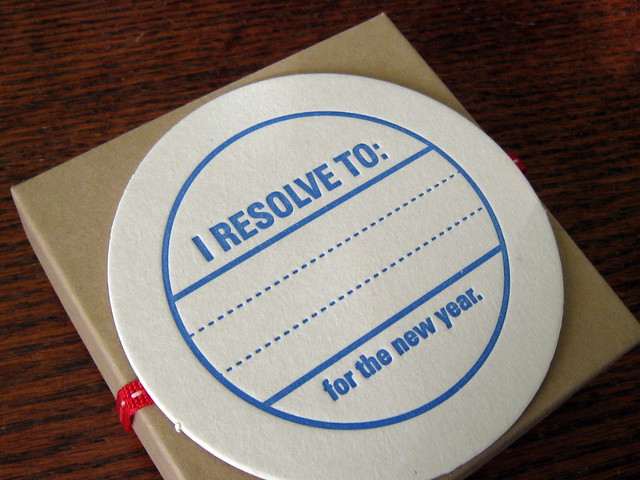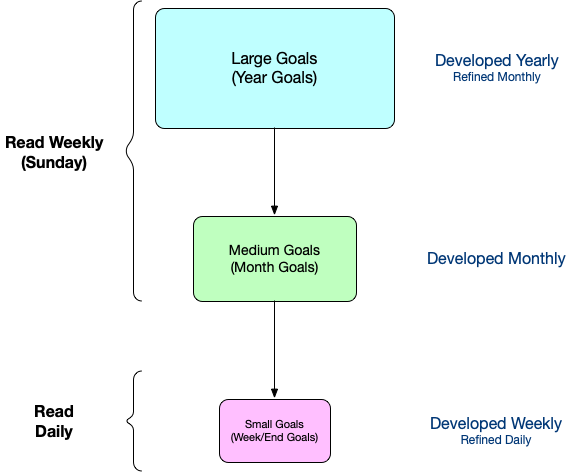
Introduction
New Years Resolutions tend to get a bad wrap - or maybe more accurate, I hear fairly negative things about it.
I believe that one reason why resolutions like this are bad has to do a few factors, including:
- People wait til once a year to do it.
- People keep with it for a short time, and failure is exceptionally high. [1]
- People get too focused on the goal, and less about what kind of person they want to be.
I wanted to address some of the reasons why I believe that resolutions fail, and what can help.
Don’t Wait, Start Sooner
Most often, I find people waiting for some time (often in the future) for when to start something. It could be the beginning of next year, or the beginning of next year. I used to do this, as well. Either way, waiting is largely unnecessary.
Furthermore, just because one stumbles or fails temporarily, doesn’t mean that you should wait again to try again. Start now, and concentrate on getting 1% better each day (quoting Atomic Habits [3]).
The basis of “the moment” is in Zen Buddhism.
The past, being a failure, is in the past and isn’t something you can change. No amount of mulling, regretting, or complaining about the past will solve the past.
Focusing on the future is also a problem, because you can’t control the future. Something can come up that prevents you from starting or continuing on a goal.
Focus on Who You Want to Be, Less on Goal
One struggle we all face is the need for motivation. That motivation often times comes from a number of some kind. For example, if you have a goal of reading 5 books in a year, then you’re focused on that goal - the 5 books. Same with weight. We commonly call these S.M.A.R.T. Goals [2], and personally I used to view these as the best types of goals.
The problem with these numerical goals is that it’s easy to “put off” implementing toward that goal because “there’s always tomorrow.” This problem can be reduced if you make your periods of time for that goal less and less (e.g. read a book in 2 weeks), but until the habit forms, you’ll likely rush at the end. In the end, you’re still doing the goal for the number, not because of who you want to be.
Instead, I really like the idea that the book Atomic Habits [3] discusses. That being, that we should focus less on the final goal and more toward making “votes” into what we want to be (your Identity). As the book mentions, on page 34:
True behavior change is identity change. You might start a habit because of motivation, but the only reason you’ll stick with one is that it becomes part of your identity.
This means that instead of a New Year’s Resolution of reading 5 books, instead focus on being a “reader”. If you want to lose weight (to be healthier), then your goal should be to “do what a healthy person would do”.
Balance is Needed
There’s a conflict between the concept of S.M.A.R.T Goals [2] and Atomic Habits [3] in all this.
I believe that Atomic Habits is “more right” than S.M.A.R.T goals for this purpose, large in part because of the audience (personal vs business).
That said, I do believe S.M.A.R.T Goals can be very useful in conjunction with the Atomic Habits methodology and both should be employed to maximize one’s goal(s).
My methodology is explained in detail below, but large in part I have “Large Goals” (things that will take the whole year), “Medium Goals” (things, based off the Large Goals, that I want to focus on in a month), and “Small Goals” (things, based off “Medium Goals”) that I want to focus on in a week. Each set gets reviewed at specific times. These goals all relate to each other, and are based in my mission statement, which is a description of who I want to be.

Phases and Tracking
The Mission Statement
The mission statement is developed first, and is reviewed/refined often, but has a boundary of the year. For example, I created a base 2023 mission statement at the beginning of the year, but can add/remove/change to/it mid-way through. I have 3 categories which I classify these goals:
- Physical - These are goals that deal with the body. Maintenance and physical health.
- Mental - These deal with mood as well as religion for me. My religion of practice is Sōtō Zen [4]
- Study - These deal with professional/personal development from a mental/learning/etc. perspective.
My father taught me these, but he would put it as 3 major things to take care of every day: “Mind, Body, and Soul”
In each category, I have a narrative specifying what that goal entails. For example, in the Physical Health category I have the following:
I want to be a healthy person with a healthy weight. I want to feel more energy, be more active, and better able to handle the stresses in life.
Below that, I have questions I want to remember such as:
- What would a healthy person do? - To prompt taking the stairs more often, or going for a walk.
- Am I really hungry, or just bored? - To avoid snacking out of boredom.
This statement is printed, and posted in 3 places in my home. It’s reviewed/read out loud every Sunday.
Year Goals (New Year Resolution)
Next, comes the actual “New Years Resolution”. These are where S.M.A.R.T goals start coming into play. I have the same general categories that are in the Mission Statement, with numbers around the goals. For example, under Physical Health I have:
- Exercise at least 75% of the days (274 days)
I keep the number of goals fairly short. Why has to do with refinement in the year. I want to be able to add/remove later on as direction changes.
These are tracked on dedicated pages in my Hobonichi Journal [5]. They’re read each month.
Month Goals (Remember This)
Near the beginning of the month, I create Month goals. These goals are based in what I have for in my Year goals - or more accurately, help me to work toward those goals. Using the exercise goal above, one such example may be:
- Exercise at least 75% in the month (23 days)
These are tracked on dedicated pages in my Hobonichi Journal. They are read each week.
Along with this, and I’ll get to this more later, I track the habits. I have a sheet/pamphlet I’ll print once a month that contains all the habits I generally want to do each day.
This is on one page, double sided, cut and folded. Checked each day. This template is updated/printed once a month.
Week(end) Goals
At the beginning of the week (Sunday), and at the beginning of the weekend (Friday), I create week/weekend goals. These goals relate to my month goals, and often times, I’m reviewing the month goals while writing goals for the week/weekend.
Much like the above, they’re tracked on dedicated pages in my Hobonichi Journal. I use the “Week View” pages for tracking both the week and weekend goals. These are reviewed every day. Once a week, on Sunday, I do a retrospective for last week where I determine if I met the goals or not. I usually reflect on other things I track to determine why I would have missed the goals and how to improve. The primary goal is to improve my 1%.
Daily Goals
Every day, I use both my Hobonichi Journal, and habit sheet, to track what tasks I have in that day. These sit, open almost always to my left while I’m working. I reference the notes, often, and keep both my work tasks and home tasks in there. Often times I’m formulating the base of my week on Sunday, but each morning I also take an opportunity to fully flesh out that day for both home and work.
These goals are mutable in that anything I don’t do gets pushed to the next day. So in part this ends up a working list of things I want to get done. If there’s a future item that I need to get done, and I know the date, I put it into the journal on that date. Else, I have another location I keep track of those and review that list once a week (Emacs org-mode to be specific).
Tracking for Success
Above I mentioned some of the ways that I track, but wanted to wanted to list all the systems relevant to this topic.
- Hobonichi Journal: Tracks the year goals, progress toward it, month and week goals. Day tracking.
- Habit Tracker: A single page, double sided, that has just my habits and a few metrics I track. It’s a part of the journal, in my view.
- Excel Workbook: This helps keep track progress toward the year goals. Exercise progress, for example.
The importance of tracking can’t be understated. You can’t know if you’re on the right track unless you know where you’ve been, or where you’re at. For me, the excel notebook is primarily for reporting purposes, and is the summation of information present in the Hobonichi and Habit trackers. I create charts/reports out of it to see if I’m making good progress (expected vs actual progress).
Conclusion
I hope this gives a good high-level overview of how I approach New Years Resolutions, but more habits and identity generation. One book I referenced a few times here was “Atomic Habits”, which I strongly recommend reading. I plan on doing a review of it soon as well.
Some reading this may think “this is too much work”, and in a way it is a lot of work. But, like anything, it gets easier. I spend less than 30 minutes a day preparing my tasks for the day (work and home). I spend less than an hour Sundays reviewing the Mission Statement, New Years Resolutions, week planning/goals, and retrospectives. The time I save elsewhere (e.g. knowing what needs to be done), and the mood improvements (being productive, meeting goals, etc.) are worth it.
I use the same methodology for my primary work-related goals, and often times the professional goals are integrated with my personal goals.

